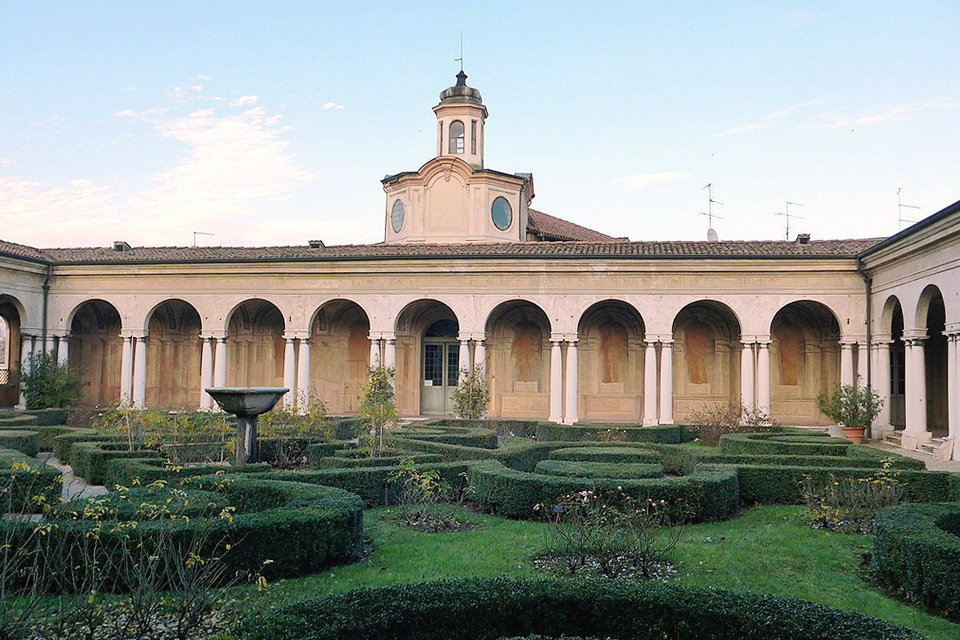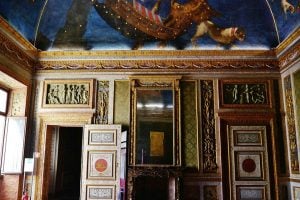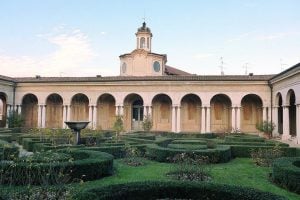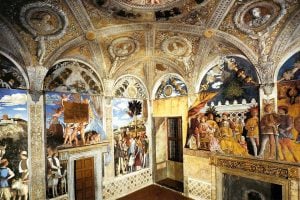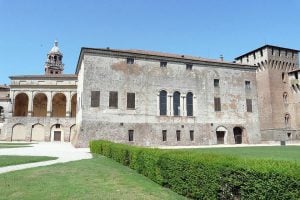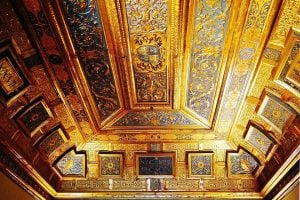The Ducal Palace architectural complex is made up of numerous buildings connected by corridors and galleries, and enriched by internal courtyards, some wall units, and vast gardens.
Giardino dei Semplici
The Garden of the Simple also known as the Garden of the Pavilion preserves the original layout of the plants. Built in the fifteenth century at the same time as the Domus Nova. In 1603 it was rearranged by the Florentine friar Zenobio Bocchi, who placed the medicinal plants, called “the simple ones”. This garden was particularly important for the hygiene of the members of the Signoria. It seems, in fact, that during the winter they never washed, but perfumed the clothes with flowers and the rare essence of this garden.
Initially it had the name of vegetable garden of the simple. The word simple derives from the medieval Latin medicamentum or simplex medicine used to define medicinal herbs. It is a vegetable garden for the cultivation of herbs and medicinal plants, often placed near the infirmary.
The “simple”, or officinal plants, were over the centuries and still are today, through their active principles, the foundation of the therapy that is as old as humanity. Near the end of the century. VI the very learned Bishop of Seville, Isidoro, advised cultivating medicinal plants in a “botanical garden” (botanicum herbarium). In the silence of the abbeys, even the monks dedicated themselves to the research of herbs and their cultivation in cloister gardens. But the real “gardens of the simple” arose and developed in the Renaissance: according to some authors, it seems that it was Nicolò V, first, to realize the first collection of rare plants in the Vatican gardens “in order to form a garden of simple. ”
According to others, the foundation of the simple vegetable garden in the Vatican is due to Leo X and Leonardo da Vinci because precisely for the interest of Leo X the chair of Botany was established in Rome in 1513 and, the following year, he was called as Reader Giuliano from Foligno.
In Casamari we still find behind the Basilica, now called the “Garden of Novices”, the location of the small “simple vegetable garden” of the past, incorporated in the ancient viridarium, and this serves to document that ab antiquo also the monks of Casamari they devoted themselves to the ars medicandi. For preservation, after drying in a well-ventilated environment, the so-called armarium pigmentariorum existed primitively in the monastery, which was a solid wood wardrobe, without glass doors, so that the plants would remain in complete darkness. In addition to drying, the monks kept the “simple” with the preparation of syrups, tinctures, macerations in alcohol, etc.
Until 1970, in the gardens and enclosure of the enclosure of the abbey of Casamari, the monks took care of the cultivation of plants and aromatic and medicinal herbs, while some plants, still today grow there spontaneously, as if to witness the ancient culture that made of them.
In truth the interest in medicinal plants was always alive in the monks of Casamari and we have proof of this in some manuscripts, yellowed by time, which still today are kept in the archives. The various lootings suffered by the abbey caused the destruction of the most ancient documents of the silent work of the monks of Casamari in the search for the most suitable means for treating diseases, but the correspondence that has come down to us is sufficient to bear witness to a centuries-old tradition.
Giardino Pensile
The hanging garden in the refectory, a late sixteenth-century building created by the Mantuan architect Pompeo Pedemonte at the request of the duke Guglielmo Gonzaga, is placed at 12 m in height. In the eighteenth century, in the period of Austrian domination, a Caffehaus was built on a project by Antonio Galli from Bibbiena.
A hanging garden is a sustainable landscape architecture, an artistic garden or a small urban farm, attached to or built on a wall. They are mainly found in areas where land is scarce or where the farmer is mobile or not permanent.
The hanging garden is an area of vegetable soil that has no direct contact with natural soil. The hanging gardens are generally built for scenic needs and where it is not possible to build a common garden on the ground. A roof garden is in fact built above an architectural structure, flat or sloping, not necessarily elevated above ground level (or ground level), eg above the floor covering of garages underground.
The most famous hanging gardens were the legendary Hanging Gardens of Babylon. They were considered in antiquity as one of the Seven Wonders of the World, and were located in present-day Iraq.
In contemporary use, hanging gardens are a green wall on a ground level facade, a balcony, a terrace, or part of a roof garden of a home, or skyrise greenery with a residential, commercial, or government office building.
A hanging garden requires the preparation of a water drainage system, as it is often equipped with an artificial irrigation system and, in addition to the decorative function, it allows to improve the microclimate of the underlying volume (eg green roof, used for the ‘ thermal insulation thanks to the thermal inertia of the soil and of the plant cover).
Numerous researches have been conducted on the “roof-garden” theories by important personalities of architecture and urban planning, including Le Corbusier, Henri Sauvage, Antonio Sant’Elia, Adolf Loos, Jean Renaudie, Friedensreich Hundertwasser.
Giardino Segreto
The Secret Garden, an integral part of the Isabella d’Este Grotto Apartment in Corte Vecchia, was completed in 1522 by the Mantuan architect Gian Battista Covo.
The Studiolo was a private space by Isabella d’Este set up in the Ducal Palace of Mantua. Initially located on the noble floor of the castle of San Giorgio, it was transferred in 1523 to the apartments of Corte Vecchia. Isabella was the only Italian noblewoman to have a study, as proof of her fame as a cultured lady of the Renaissance, who preferred intellectual and artistic interests to a hedonistic lifestyle.
Corte Vecchia regained its new prestige when in 1519 Isabella d’Este left the residence in the Castle and moved to the ground floor of this ancient sector of the Gonzaga palace, in the said widow’s apartment. Isabella’s apartment consisted of two wings now divided by the entrance to the Cortile d’Onore. In the more private wing of the Grotto, the wooden furnishings and art collections of the two famous studios, the cave and the study moved with the princess.
Santa Croce Vecchia was a small church, as it was used in the historical period at the turn of the year one thousand. Its existence is testified by a document dated 10 May 1083 signed by Matilde di Canossa. Adjacent to the first buildings of the future Ducal Palace, it was probably the Palatine Church of the Bonacolsi and Gonzaga families, but the well-known building passion of the latter family led to the demolition of the ancient building. Duly authorized by Pope Martin V, it was Gianfrancesco Gonzaga who proceeded to demolish the old Matildic church around the year 1421which, by way of compensation, near the original place, built a chapel of late Gothic style with the same name, now no longer a place of worship, however, although largely remodeled, identifiable from the small courtyard to the widow’s apartment of Isabella d’Este.
Subsequently Guglielmo Gonzaga (1550 – 1587), will transform the environments of Corte Vecchia creating the Refectory overlooking the Hanging Garden and the Galleria degli Specchi destined to music.
Other gardens and courtyards
The Cortile della Cavallerizza also called the Prato della Mostra, was created by the architect Giovan Battista Bertani, who in 1556 standardized the buildings that enclosed him in the mannerism of Giulio Romano which characterizes the pre-existing building called ” La Rustica ” which overlooks it. It was the place where the Gonzaga horses were shown ready for sale, horses that were considered by the Gonzagas, along with dogs and hawks, the most faithful animals to man. The courtyard is characterized by the basement in a rustic ashlar typical of Giulio Romano and by the overlying order consisting of twisted half-columns.
Courtyard of the Eight Faces also called Cortile degli Orsi.
Courtyard of the Frambus.
Courtyard of Honor also known as the Ducal Garden.
Courtyard of the Holy Cross.
Courtyard of the Dogs.
Ducal Palace
On account of its size, with more than 900 rooms in total, and for its masterpieces, the Ducal Palace of Mantua is a building like no other in Europe. It boasts untold artistic riches: the Camera degli sposi, featuring fresco paintings by Andrea Mantegna, Pisanello’s frescoes of courtly life, Flemish tapestries from cartoons by Raphael, an altarpiece by Rubens, paintings by Domenico Fetti, a collection of 14th century artworks, as well as the beautiful wooden inlays and frescoes – ranging from the age of the Renaissance to the 18th century – that adorn the studiolo of Isabelle d’Este. Gardens, internal courtyards, decorative elements, the Temple of Santa Barbara, the view of the lakes. A complex that burst to fruition as soon as the Gonzaga family seized power and that was constantly developed, with renovations of the oldest buildings, until the age of the Empress Maria Theresa.
Mantova Urban Museum
A city raised on the shores of beautiful lakes which in the past encircled and decorated it. A city celebrated by Virgil who was born in Andes: “I will raise a marble temple in the green countryside”. A city which hosts the most ancient christian relic, Jesus’ Blood that drained on Longino’s lance. A free city, raised in spite of matildic domination. A miracle of the Reinassance which has its center in the Ducale Palace and in the “Camera Picta” by Andrea Mantegna. A sixteenth century court which has collected infinite masterpieces, while the music and the theatre created unique moments.
Finally, a city which hosted treasures, part of many ages and cultures, in the Teresiana Library, in the National Archive, in the museums. All these elements explain, together with Festilavletteratura, the title of Italian Capital of Culture 2016.
